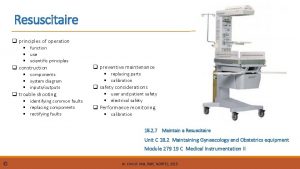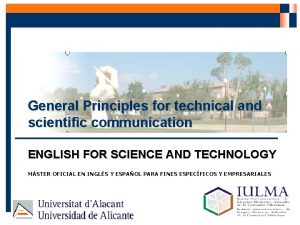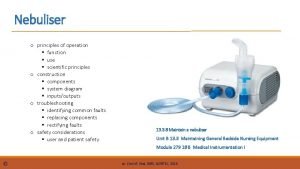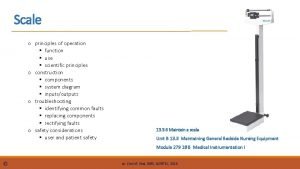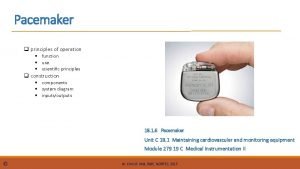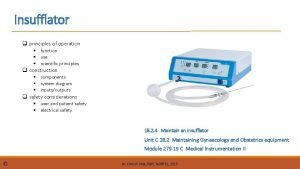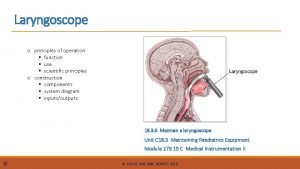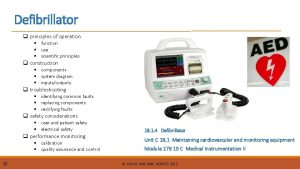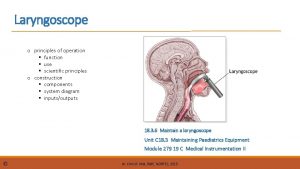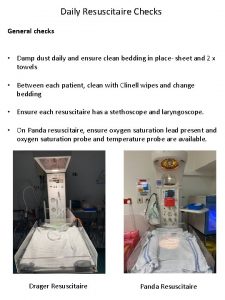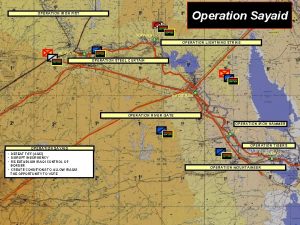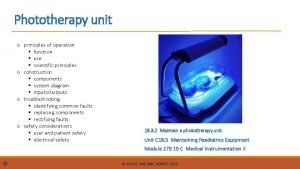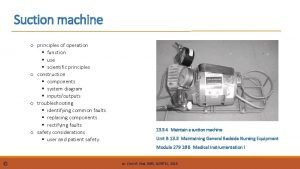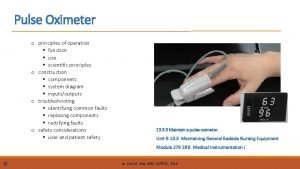Resuscitaire q principles of operation function use scientific


















- Slides: 18

Resuscitaire q principles of operation § function § use § scientific principles q construction § components § system diagram § inputs/outputs q trouble shooting § identifying common faults § replacing components § rectifying faults q preventive maintenance § replacing parts § calibration q safety considerations § user and patient safety § electrical safety q Performance monitoring § calibration 18. 2. 7 Maintain a Resuscitaire Unit C 18. 2 Maintaining Gynaecology and Obstetrics equipment Module 279 19 C Medical Instrumentation II © dr. Chris R. Mol, BME, NORTEC, 2015

Resuscitaire A resuscitaire creates a controlled environment to give intensive care to new-born children who may experience some difficulties. E. g. the baby may not breath well, maybe due to inadequate oxygenation of the mother’s blood or inadequate blood flow during anaesthesia. Environmental factors that are controlled by the resuscitaire : • temperature • humidity • oxygen • light In addition, the unit includes medical equipment for immediate use such as: • suction unit • ventilator • gas flow meter • Apgar timer © dr. Chris R. Mol, BME, NORTEC, 2015 Resuscitaire

Function: thermo-regulation At birth, an infant emerges from a warm, wet environment into a relatively cool, dry one regulated for the comfort of hospital staff and labouring mothers. Unable to maintain adequate thermal equilibrium, the infant rapidly loses heat. Simple measures, such as drying, swaddling in blankets and close contact with the mother can be effective in controlling the infant’s body temperature. While simple measures are adequate for most full-term infants, premature and low-birth-weight infants frequently require thermal support. Faulty thermo-regulation in a baby is an early warning signal of stress and potentially serious complications. © dr. Chris R. Mol, BME, NORTEC, 2015 Resuscitaire

Function: warming To regulate body temperature most resuscitaires use a Radiant warmer / heater, combined with an insulating mattress. The heater is positioned approximately 1 meter above the level of the infant, reflecting heat downwards. The warmer has a Pre-Warm mode, a Manual mode or a Baby mode. In the Baby mode, the unit uses a temperature sensor which needs to be connected to the baby (at the location of the liver, which usually has good blood flow). The system allows the user to set a temperature range. This range is then automatically maintained by the system. In manual mode, which needs to be used if the temperature sensor is broken or lost, the heater will operate in manual mode, with constant output. This mode is more dangerous as the baby can be overheated. A warmer head pivot can be present to rotate the warmer to the side to enable X-ray procedures. stand alone radiant heater © dr. Chris R. Mol, BME, NORTEC, 2015 Resuscitaire

Function: ventilation The ventilator needs to make sure that the air pressure is as low as possible to get a given volume of air/oxygen into the lungs. The baby’s lung compliance changes continuously. The ventilator pressure must be adapted to take this into account. © dr. Chris R. Mol, BME, NORTEC, 2015 Resuscitaire

Function: lighting Resuscitaires (and infant warmers) have exam lights built into the warming hoods. The exam lights can vary from simple incandescent light bulbs, to mini-spot lights to reflector type (Halogen) lamps. © dr. Chris R. Mol, BME, NORTEC, 2015 Resuscitaire

Resuscitaire Use: Approach / priorities © dr. Chris R. Mol, BME, NORTEC, 2015 Resuscitaire

Apgar score: measuring the status of the newborn Virginia Apgar invented the Apgar score in 1952 as a method to quickly summarize the health of new-born children. The Apgar scale is determined by evaluating the new-born baby on five simple criteria on a scale from zero to two, then summing up the five values thus obtained. The resulting Apgar score ranges from zero to 10. The five criteria are summarized using words chosen to form a acronym (‘Apgar’) as indicated in the right hand column the five criteria of the Apgar score © dr. Chris R. Mol, BME, NORTEC, 2015 Resuscitaire

Apgar score and Apgar timer The test is generally done at one and five minutes after birth, and may be repeated later if the score is and remains low. • Apgar scores 7 and above are generally normal, • Apgar scores 4 to 6 fairly low, • Apgar scores 3 and below are generally regarded as critically low. A low score on the one-minute test may show that the neonate requires medical attention but does not necessarily indicate a long-term problem, particularly if the score improves at the five-minute test. An Apgar score that remains below 3 at later times—such as 10, 15, or 30 minutes—may indicate longer-term neurological damage. Not that the Apgar test's purpose is to determine quickly whether a new-born needs immediate medical care. It is not designed to predict long term health issues. An Apgar Timer will sound a buzzer for the duration of 3 seconds at intervals of 1, 5, and 10 minutes, thereby supporting the user to take the Apgar scores at precise intervals. © dr. Chris R. Mol, BME, NORTEC, 2015 Resuscitaire

System Overview and Components (example) © dr. Chris R. Mol, BME, NORTEC, 2015 Resuscitaire

Components (selection) The Bassinet side and front panels may be folded down to permit maximum access to the infant. The mattress may be tilted up in the rear at a 5 or 10 degree angle. Openings are provided on each side of the bassinet for the insertion of an (optional) X-ray Cassette Tray. The Controller controls all functions, including the user interface control, the timing of the pre-heating, alarms, the Apgar Timer, the Skin Temperature probe, thermostat, etc. The Blended Gas supply unit mixes air and oxygen, to be used during ventilation. The Suction machine, bottle and filter are needed to e. g. remove fluids from new-born airways. © dr. Chris R. Mol, BME, NORTEC, 2015 Resuscitaire

Ventilator and Gas supply control (example) © dr. Chris R. Mol, BME, NORTEC, 2015 Resuscitaire

Alarms High Temperature Alarm: when skin temperature exceeds 39. 0 OC the heater is automatically turned off and an alarm is given. Probe fail Alarm: if the Skin Temperature Probe fails (short-circuited or open). Baby Temperature Alarm: when the temperature sensed by the Skin Temperature Probe is 1 OC above or 1 OC below the selected Set Temperature Display setting. Apgar Timer: the timer will show elapsed minutes and seconds and the audible alarm will sound at the 1, 5 and 10 minute Apgar time intervals. Power Fail Alarm: if the Power is interrupted while the controller is on. System Fail Alarm: if an internal malfunction is detected; an error code may be displayed. Blender Differential Bypass Alarm: will sound when the pressure differential between O 2 and Air supplies exceeds 20 psi. When this occurs, the blender will continue to supply whichever gas is at the higher pressure: either 100% air or 100% Oxygen. © dr. Chris R. Mol, BME, NORTEC, 2015 Resuscitaire

Input / Output Inputs • • © air oxygen water power Outputs • air/oxygen under pressure for ventilation • heat for warming • light • suction • alarms dr. Chris R. Mol, BME, NORTEC, 2015 Resuscitaire

Trouble shooting: temperature measurement The temperature probe is a frequent problem. The technology in the probe is simple; typically just a thermistor. However, determining the exact type and resistance of thermistor requires data from the manufacturer. If this data can be obtained, than a replacement probe can be manufactured from a standard thermistor and the proper connector. Without the manufacturer’s data, it can be impossible to construct the probe. A possible solution to a missing thermistor probe is to place a known, fixed resistor in its place, essentially forcing the device to operate in manual mode. A potentiometer can be used to determine the value of resistance that is required to force the lights to come on. Thermocouple probes are sometimes used on warming units, in which case a resistance will not substitute for the probe. A voltage source might work, however. Using a potentiometer, a battery and a fixed resistor, a voltage divider can sometimes be created and adjusted until the warming unit comes on. Since the device is now in manual mode, care should be used to insure that the patient’s temperature is carefully monitored. © dr. Chris R. Mol, BME, NORTEC, 2015 Resuscitaire

Trouble shooting The same types of faults occur as on anaesthetic machine: • gas leaks, • rotameters stuck, • suction not working, these can be dealt with in the same way as described in those sections. The system needs to be checked for electrically safety at least once a year. © dr. Chris R. Mol, BME, NORTEC, 2015 Resuscitaire

Safety considerations Hyperthermia or burning is a distinct possibility and can result in skin burns, permanent brain damage, or death. Temperature/heater control is therefore critical. The overhead heaters should not be closer to the baby than 24 inches. Fires can result from flammable objects (e. g. , oxygen hoses, drapes) © dr. Chris R. Mol, BME, NORTEC, 2015 Resuscitaire

END The creation of this presentation was supported by a grant from THET: see https: //www. thet. org/
 What is a resuscitaire
What is a resuscitaire Information gathered during an experiment
Information gathered during an experiment How is a scientific law different from a scientific theory?
How is a scientific law different from a scientific theory? Chapter 5 principles of engine operation
Chapter 5 principles of engine operation Voltage coe
Voltage coe Radical functions unit test edgenuity
Radical functions unit test edgenuity Function operations definition
Function operations definition Front office division
Front office division Objectives of operations
Objectives of operations Perform operations on functions
Perform operations on functions Frederick winslow taylor parents
Frederick winslow taylor parents Principles of science
Principles of science Engineering notation examples
Engineering notation examples Principles of rational drug use
Principles of rational drug use Yesterday
Yesterday Homeostasis animal
Homeostasis animal Basic principles of animal form and function
Basic principles of animal form and function A jeepney ride costs 9 pesos for the first 4 kilometers
A jeepney ride costs 9 pesos for the first 4 kilometers Evaluate the function.
Evaluate the function.
